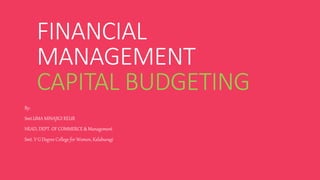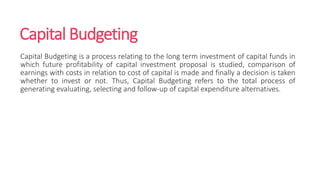Capital budgeting theory
- 1. FINANCIAL MANAGEMENT CAPITAL BUDGETING By: Smt.UMA MINAJIGI REUR HEAD, DEPT. OF COMMERCE & Management Smt. V G Degree College for Women, Kalaburagi
- 2. CAPITAL BUDGETING Capital budgeting, and investment appraisal, is the planning process used to determine whether an organization's long term investments such as new machinery, replacement of machinery, new plants, new products, and research development projects are worth the funding of cash through the firm's capitalization structure (debt, equity or retained earnings). It is the process of allocating resources for major capital, or investment, expenditures. One of the primary goals of capital budgeting investments is to increase the value of the firm to the shareholders.
- 3. What is Capital Budgeting? Capital budgeting is a process of evaluating investments and huge expenses in order to obtain the best returns on investment. An organization is often faced with the challenges of selecting between two projects/investments or the buy vs replace decision. Ideally, an organization would like to invest in all profitable projects but due to the limitation on the availability of capital an organization has to choose between different projects/investments.
- 4. Your mobile phone has stopped working! Now, you have two choices: Either buy a new one or get the same mobile repaired. Here, you may conclude that the costs of repairing the mobile increases the life of the phone. However, there could be a possibility that the cost to buy a new cell phone would be lesser than its repair costs. So, you decide to replace your cell phone and you proceed to look at different phones that fit your budget! Capital budgeting as a concept affects our daily lives. Let’s look at an example-
- 5. Capital Budgeting Capital Budgeting is a process relating to the long term investment of capital funds in which future profitability of capital investment proposal is studied, comparison of earnings with costs in relation to cost of capital is made and finally a decision is taken whether to invest or not. Thus, Capital Budgeting refers to the total process of generating evaluating, selecting and follow-up of capital expenditure alternatives.
- 6. Definitions: Prof I.M Pandy defines, “Capital Budgeting decision as the firm’s decision to invest it’s current funds most efficiently in long term activities, in anticipation of an expected flow of future benefits over a series of years.” Hampton Johan J has defined Capital Budgeting as, “A firm’s formal planning process for the acquisition and investment of capital”.
- 7. Objectives of Capital budgeting What are the objectives of Capital budgeting? Capital expenditures are huge and have a long-term effect. Therefore, while capital budgeting analysis an organization must keep the following 1. Selecting profitable projects An organization comes across various profitable projects frequently. But due restrictions, an organization needs to select the right mix of profitable increase its shareholders’ wealth. 2. Capital expenditure control Selecting the most profitable investment is the main objective of capital However, controlling capital costs is also an important objective. Forecasting expenditure requirements and budgeting for it, and ensuring no investment are lost is the crux of budgeting. 3. Finding the right sources for funds Determining the quantum of funds and the sources for procuring them is important objective of capital budgeting. Finding the balance between the borrowing and returns on investment is an important goal of Capital
- 8. Capital Budgeting Process Capital Budgeting Process The process of capital budgeting is as follows:
- 9. 1. Identifying investment opportunities An organization needs to first identify an investment opportunity. An investment opportunity can be anything from a new business line to product expansion to purchasing a new asset. For example, a company finds two new products that they can add to their product line. 2. Evaluating investment proposals Once an investment opportunity has been recognized an organization needs to evaluate its options for investment. That is to say, once it is decided that new product/products should be added to the product line, the next step would be deciding on how to acquire these products. There might be multiple ways of acquiring them. Some of these products could be: •Manufactured In-house •Manufactured by Outsourcing manufacturing the process, or •Purchased from the market Capital Budgeting Process
- 10. 3. Choosing a profitable investment Once the investment opportunities are identified and all proposals are evaluated an organization needs to decide the most profitable investment and select it. While selecting a particular project an organization may have to use the technique of capital rationing to rank the projects as per returns and select the best option available. In our example, the company here has to decide what is more profitable for them. Manufacturing or purchasing one or both of the products or scrapping the idea of acquiring both. 4. Capital Budgeting and Apportionment After the project is selected an organization needs to fund this project. To fund the project it needs to identify the sources of funds and allocate it accordingly. The sources of these funds could be reserves, investments, loans or any other available channel.
- 11. 5. Performance Review The last step in the process of capital budgeting is reviewing the investment. Initially, the organization had selected a particular investment for a predicted return. So now, they will compare the investments expected performance to the actual performance. In our example, when the screening for the most profitable investment happened, an expected return would have been worked out. Once the investment is made, the products are released in the market, the profits earned from its sales should be compared to the set expected returns. This will help in the performance review.
- 12. 1. Identifying investment opportunities 2. Evaluating investment proposals 3. Choosing a profitable investment 4. Capital Budgeting and Apportionment 5. Performance Review Capital Budgeting Process
- 13. Methods of Capital Budgeting The following are the two methods: A) Traditional Method 1. Pay back period method 2. Improvement of traditional approach 3. Rate of Return Method or Accounting Method B) Time adjusted method or discount methods 4. Net Present Value method 5. Internal Rate of Return Method 6. Profitability Index Method
- 14. Pay Back Period Method Pay back method is popularly known as pay-off or pay-out or replacement period method. According to this method, it measures the number of years required to recover the original cash outlay invested in a project. It measures the period of time for the original cost of project to be recovered from the additional earnings of the project itself. When there are two or more projects, the projects having the lesser number of pay- back period within the standard recoupment period will be accepted.
- 15. The pay back period is calculated in the following manner: 1. Calculate annual earnings before depreciation after taxes because they are called annual cash flows. 2. Divide the initial cost i.e, cost of investment by the annual cash inflow if the annual earnings is constant. 𝑃𝑎𝑦 𝑏𝑎𝑐𝑘 𝑝𝑒𝑟𝑖𝑜𝑑 = 𝑂𝑟𝑖𝑔𝑖𝑛𝑎𝑙 𝑐𝑜𝑠𝑡 𝑜𝑓 𝑡ℎ𝑒 𝑎𝑠𝑠𝑒𝑡 𝐴𝑛𝑛𝑢𝑎𝑙 𝑐𝑎𝑠ℎ 𝑖𝑛𝑓𝑙𝑜𝑤𝑠 3. If the annual earning is constant, in such cases, pay back period can be calculated by adding up the cash inflows.
- 16. How to calculate Cost of the project: Particulars Amount Cost of land and building, Machine X Tools and Equipment's XX Add: Cost of installation and Erection charges X XXX Less: Tax concessions X Cost of project (cash outflows) XX Cost of project (Cash out flows) is calculated in the following manner: Note: Salvage value is not considered while calculating cash outflow, because it is releasable at the particular period. 4. If the annual profit is not constant i.e, unequal (Cumulative method) The annual cash inflows is accumulated till the recovery of investment and as soon as this amount recovered it is the expected number of years of pay back.
- 17. How to calculate pay back period: If the annual earning is constant: Calculated Annual earning (i.e, Profit) before depreciation and after taxes is called Cash inflows. 𝑃𝑎𝑦 𝑏𝑎𝑐𝑘 𝑝𝑒𝑟𝑖𝑜𝑑 = 𝑂𝑟𝑖𝑔𝑖𝑛𝑎𝑙 𝑐𝑜𝑠𝑡 𝑜𝑓 𝑡ℎ𝑒 𝑎𝑠𝑠𝑒𝑡 𝐴𝑛𝑛𝑢𝑎𝑙 𝑐𝑎𝑠ℎ 𝑖𝑛𝑓𝑙𝑜𝑤𝑠
- 18. Calculation of CashFlows After Tax (CFAT) Method-I Particulars Amount Profit before Tax XXX Less: Tax X Profit after tax (PAT) XX Add: Depreciation X Add: Salvage Value X Add: Recovery of working capital X Profit before Depreciation and after tax (Annual Cash Inflows) XXX
- 19. Particulars Amount Sales (Cash) XXX Less: Operating expenses paid in cash X Less: Depreciation X Profit before tax XX Less: Tax X Profit after tax XX Add: Depreciation X Net cash inflows XXX Calculationof CashFlows After Tax (CFAT) Method-II
- 20. Thank You




















